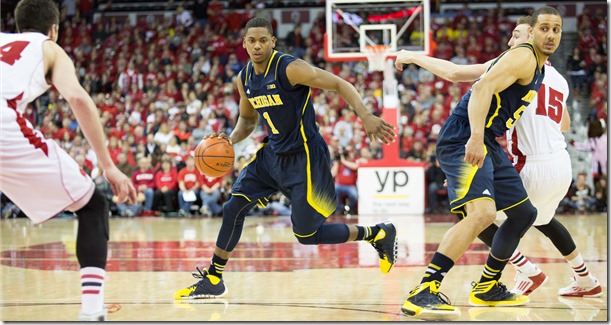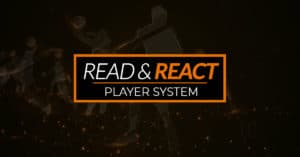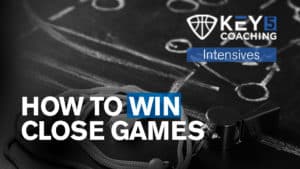In this article I am going to talk about the different techniques to defend the middle pick & roll. In my opinion, a middle pick & roll is anything set from the free-throw line extended and above. I also believe there are two different types of middle pick & rolls: Flat and Angled. (See Images Below) Additionally, each type of pick & roll can be guarded differently depending on personnel and game plan.
Flat Pick & Roll: “Weak”
Several Summer’s back I learned a term/concept from LA Clippers head coach Doc Rivers, “Weak”. “Weak” means he wants to push the ball handler to dribble using their left (usually Weak) hand. Doc uses this concept regardless if the ball handler is right-handed or left-handed as he believes 9/10 times they will be right-handed. Additionally, if you are always pushing the ball handler the same direction, the rest of your defense will know their rotations every time. I believe this is a term that most middle and high school coaches could implement into their game plan on a nightly basis. Note: this typically should only be used in the middle of the floor.
This is how you will see his bigs and many others in the NBA “Weak” a flat pick & roll. As soon as your big sees his man sprinting into a pick, have them yell out, “Weak, Weak, Weak!”, this notifies the guard that we want to push him to his left hand. Now it’s the guards turn, he needs to change his stance to force the ball handler to dribble using his left hand. This is where some guards can get split. We aren’t saying to totally turn your hips and play “ole” defense; the guard needs to adjust his stance to sit on the ball handlers right hip to forcing them to the left hand (Funneling him to his big). Now its the bigs’ turn; he needs to sit down and get wide in an athletic position. As the ball handler starts dribbling off and the guard is fighting over the screen, the big needs to do a great job moving his feet and staying in front of the ball handler and allowing his guard to get back in front of the ball; while the rest of your defense rotates to assist in the big rolling/popping. (See Image Below)
In my experience, there are five ways to effectively guard an angled middle pick & roll: Level, Jam, Show, Blitz, and Switching. Note: these can be utilized in any middle pick & roll situations.
1. Level: Leveling is a very similar concept to “Weak”. However, you are not forcing the ball handler to one direction. Rather your big simply levels off the screen to prevent the guard from turning the corner. This also prevents the defense from getting burned if the ball handler turns down the screen. The big sits back and waits until the guard comes off of the screen before he takes action.
2. Jam: Jamming is a very popular term that I am sure most of you already use. Jamming has also been called “Lifting” as it might be a better name for teaching the technique. As the game has progressed and officials are now calling more and more touch fouls, Jamming is turning into more of a “Hug Up & Under” technique; so this is the technique I will describe. Typically it is easiest to Jam a screen when the big is stationary and NOT sprinting into the pick. As the ball handler is approaching the screen, the defender hugs up against the picker and attempts to move the screen up (without fouling) as the guard sprints underneath. Note: this technique should not be used if the ball handler can shoot as it is easy to stop and pop behind the screen.
3. Show: Showing should be used when you want to slow down the guard coming off the pick. Many coaches refer to this as a “Hedge”. But I like the term “Show” as it entails that you are quickly stepping out and showing yourself to the ball handler. As the ball handler begins coming off, the big needs to meet him at the level of the screen and force him to take at least two back dribbles toward half-court; this will give your guard time to recover. As the guard recovers, he will go over top of the pick, but under the big. A key point to Showing is communication, the guard needs to communicate to his big when he is back; last thing you want is the big to leave the ball before the guard has fully recovered.
4. Blitz: Blitzing should be used when you want to try to turn the ball handler over or force him to get rid of the ball. Again, many coaches may use the term “Trap”, but I prefer the term “Blitz” as it signifies a sense of urgency and aggression. As the ball handler begins coming off, the big needs to meet him at the level of the screen to prevent the split and start forcing him towards half-court. At the same time your guard fights over top of the screen and they essentially trap and/or contain the ball handler trying to push him to half-court. Key is not to commit a foul.
5. Switch: Switching should only be used in two situations: late in the clock and if the players you are switching are similar in position (i.e-Pending the game plan you could switch 1-3, or switch big on big, etc.). Too often I see players switch ineffectively and either they get split or burned on the slip. The key to switching is both defenders must come together. Never switch a screen until both defenders are close enough to touch hands.
Now that you have all of these concepts you may be asking, which one is the most effective? That all depends on your game plan, personnel, and time & score. Nevertheless, E.L.C. needs to be enforced in every situation!














